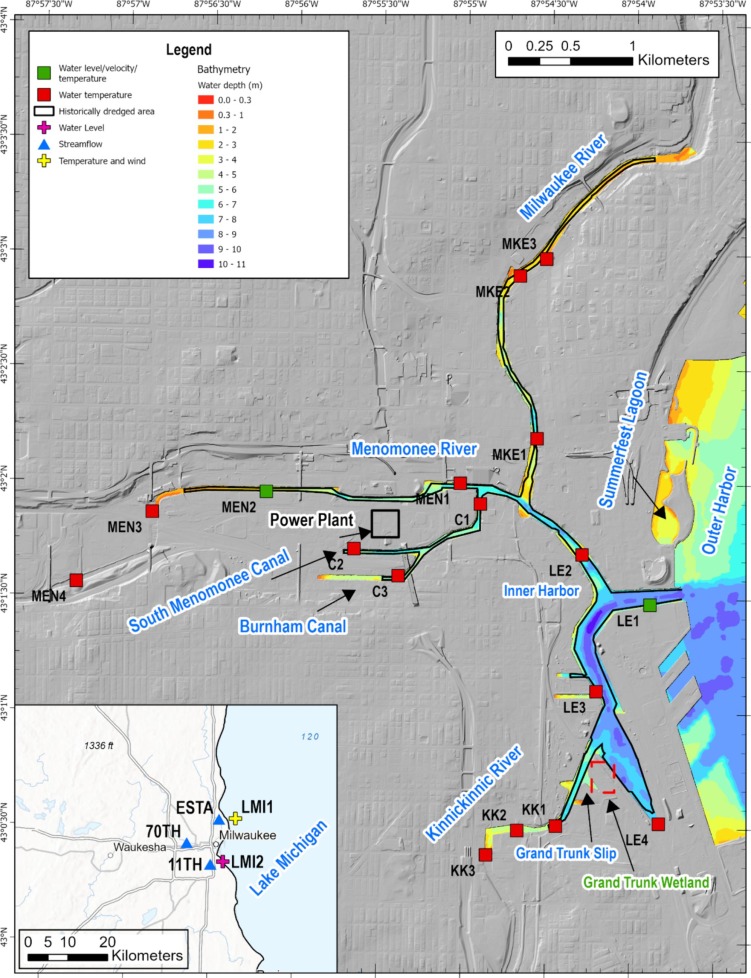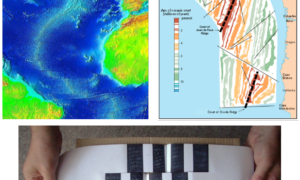The thermal regime of coastal estuaries is heavily influenced by their neighboring waters. In the case of Lake Michigan, the Milwaukee Estuary’s temperature fluctuates rapidly, impacting the habitat suitability of the estuary for a variety of species that reside there or rely on the estuary as a spawning ground before moving to deeper waters.
South Menomonee Canal – Milwaukee, Wisconsin, USA. (Credit: Giorgio Galeotti via Wikimedia Commons CC BY-SA 4.0)
In order to protect the larger Great Lakes ecosystem and regional fisheries, it’s vital that the drivers of such thermal changes be studied and understood for effective, informed management of the region’s natural resources.
A 2024 study published in the Journal of Great Lakes Research studied temperature variation in the Milwaukee Estuary of Lake Michigan between July and October of 2019 to document spatial and temporal variations in water temperatures due to lake-related upwelling and downwelling, as well as rainfall-driven runoff events.1
The hypothesis of the study was that meteorological conditions over the lake would be the primary driver of changes in the estuary’s thermal regime. Additionally, it was believed that summer water temperatures in Great Lakes estuaries fluctuated rapidly in response to changing wind and weather in the nearshore environment.1
Objectives of the study were as follows:
- Identify the major drivers of temperature changes during the thermally stratified season.
- Describe the spatial and temporal extent of thermal changes.
- Address what these events may mean for local biota in the Milwaukee Estuary.1
Methods

Map of the Milwaukee Estuary showing bathymetry as well as the location of the Menomonee, Milwaukee, and Kinnickinnic Rivers, Lake Michigan, Inner and Outer Harbors, Grand Trunk Slip and Wetland, Burnham Canal, South Menomonee Canal, and data collection sites for the present study. (Credit: Stefaniak et al., 2024)
HOBO Pendant MX2201 temperature loggers were deployed at 18 sites throughout the estuary and its tributaries to record data continuously between July and October. Temperature profiles of the Menomonee River, Milwaukee River, Kinnickinnic River, and Menomonee Canal were also collected by boat tows conducted on August 30, 2019.
Some of the sensors were strategically placed where upwellings were thought to happen, and three were near previously deployed temperature sensors that have been deployed since 2017. The pendants collected measurements at five-minute intervals.
An upward-looking ADCP was deployed at approximately 8 m on the riverbed at the estuary mouth, and streamflow and temperature data were collected every 15 minutes.
Lake temperature and over-lake meteorological data (wind speed and direction) were pulled from an existing University of Wisconsin-Milwaukee research buoy.1 Finally, Lake water level data was sourced from an existing National Oceanic and Atmospheric Agency (NOAA) lake level station near 2.65 km southeast of the estuary mouth.1
Results
Results of the study revealed that, like Lake Michigan, the estuary was stratified from July to October 2019. Dredged areas with water depths greater than 6 m saw free movement of cold lake water into the estuary.
Temperatures in the estuary fluctuated rapidly both spatially and temporally in sync with observed lake temperature fluctuations driven by changes in meteorological conditions over Lake Michigan.1
Lake-driven upwelling and downwelling events influenced water temperature more than the evaluated tributaries, and periodic events caused temperature changes up to 15 ◦C in less than 24 hours.1
Nearshore upwelling allowed for this cold lake water to reach tributary portions of the estuary beyond the dredged areas. In contrast, “downwelling events disrupted thermal stratification and caused the deep, dredged portions of the estuary to exceed 20 ◦C.”1
Thermal impacts of upwelling and downwelling events were most noticeable in transition zones between dredged and not dredged channels. Additionally, warming effects from downwelling persisted for up to two weeks, while cooling effects from upwelling only lasted a few days.
Ultimately, lake-driven, rapid summer thermal regime changes must be considered in current and future habitat restoration activities happening in Great Lakes estuaries.
As a result of this phenomenon, future projects would benefit from temperature monitoring to ensure that the restored habitat is effective at providing the range of temperatures needed for productive spawning and juvenile survival of multiple fish species of interest.1
Source
- Stefaniak, O. M., Fitzpatrick, F. A., Dow, B. A., Blount, J. D., Sullivan, D. J., & Reneau, P. C. (2024). Influences of meteorological conditions, runoff, and bathymetry on summer thermal regime of a Great Lakes estuary. Journal of Great Lakes Research, 50(5), 102416. https://doi.org/10.1016/j.jglr.2024.102416




Leave a comment